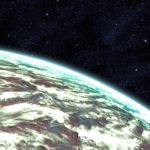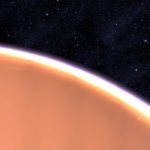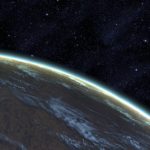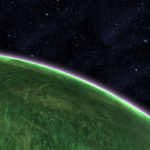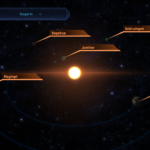System Specs:
- Stellar Mass: _ Sol Masses
- Stellar Class: _
- Luminosity: _ Sol
- Planets: 5
- Moons: 0
- Asteroid Belts: 0
- Asteroids: 0
- Objects: 0
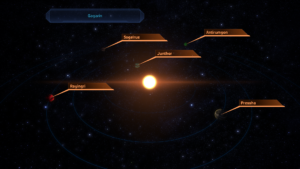
It is named after the Soviet cosmonaut Yuri Gagarin. He is best remembered as the first human who orbited the Earth, during the Vostok 1 flight of 1961.
–
Planets Directory:
- Junthor
- Pressha
- Rayingri
- Sogelrus
- Antirumgon
–
Junthor:

- Orbital Distance: 0.2 AU
- Orbital Period: _ Earth-years
- Keplerian Ratio: _ 17.863
- Radius: 10,480 km
- Day Length: 56.7 Earth-hours
- Atmospheric Pressure: 0.96 atm
- Surface Temp: -49 °C
- Surface Gravity: 0.98 g
- Mass: 2.626 Earth-masses
- Satellites: >1
Junthor is a large terrestrial planet with a thick atmosphere of carbon dioxide and chlorine. The surface is mainly composed of aluminum with deposits of nickel.
Surveyors found the ruins of a technical civilization near the equator — evidently the colony of an ancient space-faring race. The ruins had subsided to almost nothing — merely wind hollowed husks of arcologies and other mega-structures. In the center of the ruins was a single column whose inscriptions defied translation for several centuries.
When asari linguists finally managed a translation, the elaborate relief carvings said merely, “Walk among these works, and know our greatness.” The crude scratches on the base of the reverse side said, “Monsters from the id.”
–
Pressha:
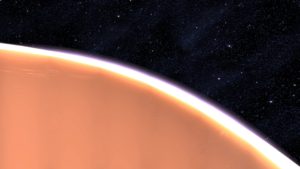
- Orbital Distance: _ AU
- Orbital Period: 0.7 Earth-years
- Keplerian Ratio: _
- Radius: 38,482 km
- Day Length: 16.2 Earth-hours
- Atmospheric Pressure: _ atm
- Surface Temp: _ °C
- Surface Gravity: _ g
- Mass: _ Earth-masses
- Satellites: >1
Pressha is a relatively small hydrogen-helium gas giant with large amounts of hydrocarbons in the middle layers of the atmosphere.
When the Krogan Rebellions ended three millennia ago, the turian chief of naval operations, a distinguished soldier named Mehrkuri, declared his immediate retirement. He disappeared into what was then uncharted territory. It was only two hundred years ago that his ship was found on the surface of Pressha’s largest moon. It had landed gently and been deliberately shut down. Of Admiral Mehrkuri, however, no trace was ever found.
Properties
Pressha is too small to be a “standard hydrogen-helium gas giant” (William Hubbard, The New Solar System 4th ed, 1999; p. 194). It is more likely a dense “ice giant” like Neptune or Gliese 436 b.
–
Rayingri:
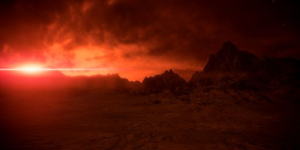
- Orbital Distance: _ AU
- Orbital Period: _ Earth-years
- Keplerian Ratio: _
- Radius: 5,171 km
- Day Length: 60.5 Earth-hours
- Atmospheric Pressure: 0.84 atm
- Surface Temp: 46 °C
- Surface Gravity: 0.87 g
- Mass: 0.568 Earth-masses
- Satellites: 1
Rayingri is a small, barren terrestrial world. While it possesses a reasonably temperate climate and a number of useful resources, no mining corporation is willing to risk investment.
A rogue planetoid, dubbed Vahtz by the initial salarian surveyor team, entered the system approximately ten thousand years ago, and was trapped in a decaying orbit around Rayingri. It is nearing the end of its slow spiral inwards. Earthquakes and cyclonic windstorms are increasingly common on Rayingri.
Within a few hundred years, the planets will rip each other apart. Some asari travel consortiums have already announced sponsorship of cruises to observe the spectacle.
–
Sogelrus:

- Orbital Distance: _ AU
- Orbital Period: 1.8 Earth-years
- Keplerian Ratio: _
- Radius: 4,327 km
- Day Length: 63.9 Earth-hours
- Atmospheric Pressure: 0.52 atm
- Surface Temp: -136 °C
- Surface Gravity: 0.46 g
- Mass: 0.21 Earth-masses
Sogelrus is a small terrestrial planet with a thin atmosphere of nitrogen and argon. The frigid surface is mainly composed of water ice, which can be plainly seen in the bottoms of recent craters. The dark coloration of the surface is caused by a carbon and ferrous material, pushed up from the denser core by cryo-volcanic processes.
–
Antirumgon:

- Orbital Distance: _ AU
- Orbital Period: 4.0 Earth-years
- Keplerian Ratio: _
- Radius: 9,508 km
- Day Length: 32.1 Earth-hours
- Atmospheric Pressure: 0.00 atm
- Surface Temp: -178 °C
- Surface Gravity: 0.90 g
- Mass: 1.985 Earth-masses
Antirumgon is a small rock and ice planet, with a trace atmosphere of methane and ethane. The frozen surface is mainly composed of carbon with deposits of calcium.
Antirumgon has been used as a crude anchorage for Terminus pirates for many years. The shells of temporary dwellings blasted by Alliance frigate patrols dot the surface. But always, the pirates return to ground their ships’ drive charges, chip out some water ice, and trade slaves and stories.
The deeper layers of Antirumgon’s interior are semi-liquid slush, due to the presence of methanol. It is thought that bacterium in the deep core create this natural anti-freeze. Some species of Terminus pirate drill through the ice crust to recover this natural alcohol.
–
video
